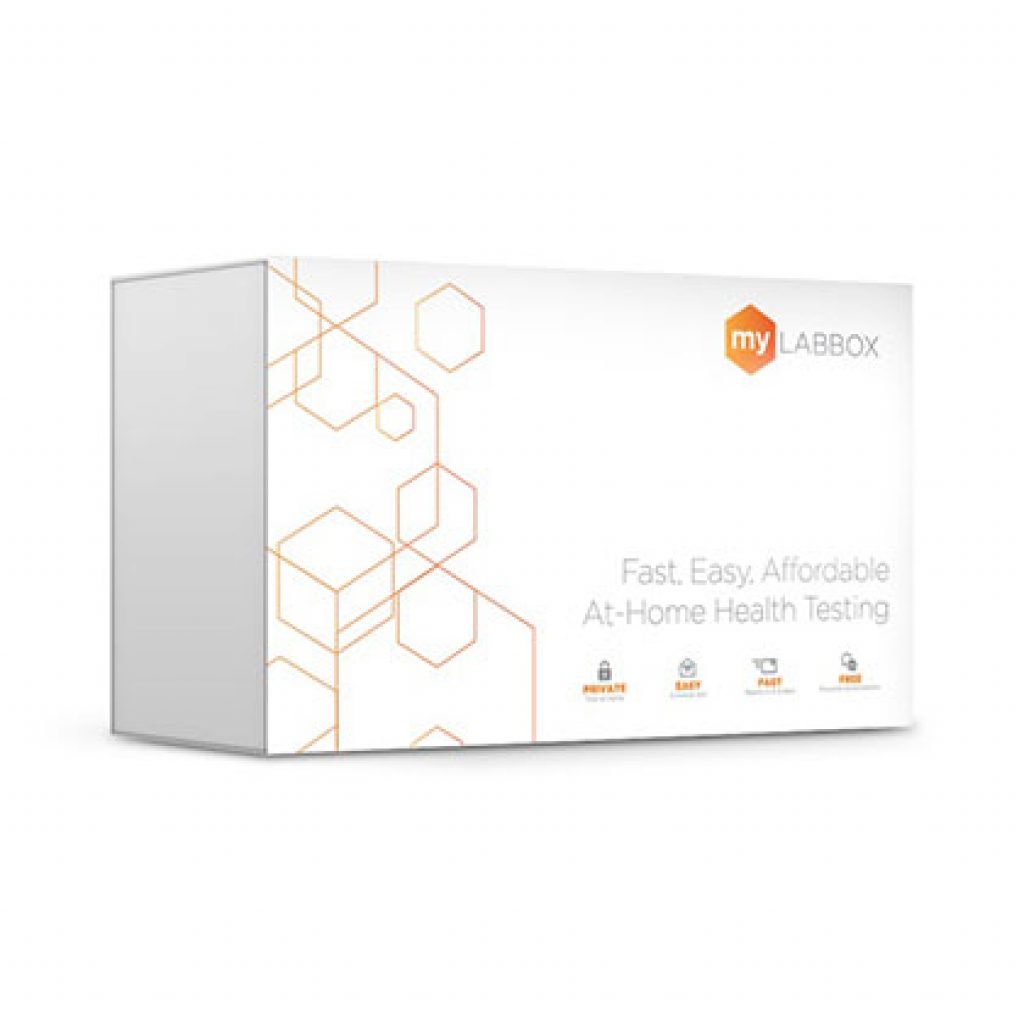When you have a food intolerance, you will know! At least that’s what pretty much everyone who experiences not-so-pleasant symptoms after eating specific foods will tell you. And while they are not life-threatening, food intolerances can cause discomfort, which is why getting an accurate diagnosis, and eliminating the food that’s causing issues from your diet can be pretty life-changing.

myLAB Box
Food Sensitivity Test
Immunoglobulin lgA, IgG, IgG4
96 Common Foods
Free shipping
Finger Prick Sample
$149.00
The myLAB Box at-home food sensitivity test checks for elevated antibodies in your blood sample, to determine whether you have had an intolerant reaction to 96 common foods.
Read our myLAB Box review for information and opinions on tests and services.
Read: Are food sensitivity tests accurate?
Here is everything you need to know about the most common food intolerances to help you to take the steps toward getting the answers you need.
Lactose
Lactose intolerance is one of the most common food intolerances out there. It is a problem that occurs when the body is unable to digest lactose, a sugar found in milk and dairy products. Some of the most common signs and symptoms are diarrhea, nausea, stomach cramps, and bloating after eating foods containing lactose.
Why does it happen? It’s thought that lactose intolerance occurs when your small intestine doesn’t produce enough of the enzyme lactase to digest milk sugar aka lactose. However, there are also certain conditions that can put you at a higher risk, including
- Bacterial overgrowth
- Celiac disease
- Crohn’s disease
As mentioned lactose is mainly found in milk and dairy products, these include
- Cows milk
- Goats milk
- Yogurt
- Cheese
- Ice cream
- Some cereals
If you frequently experience discomfort after eating dairy products, it’s important to speak with your doctor to find out the underlying cause. If you are diagnosed with lactose intolerance, it’s likely that your doctor will recommend you follow a low-lactose diet, which involves limiting dairy products and eating or drinking lactose-reduced ice cream and milk.
Gluten
Gluten intolerance is arguably one of the most spoken about intolerances in recent years. It occurs when a person has issues digesting foods containing gluten, a protein found in wheat, barley, rye, and triticale. Common symptoms include stomach cramps, bloating, fatigue and diarrhea after eating gluten-free foods.
Gluten intolerance is often confused with celiac disease, an autoimmune condition involving the small intestine, whereas gluten intolerance involves the digestive system and is not as severe. Other conditions associated with gluten include
- Non-celiac gluten sensitivity
- Wheat allergy
Gluten is found in grains found in a number of foods, just some of these foods include
- Bread
- Cakes and pies
- Cereals
- Pasta
- Bulgur wheat
- Certain sauces
If you suspect that you have a gluten intolerance, make an appointment with your doctor. If you are diagnosed, they may recommend you follow a gluten-free diet to help manage your symptoms, this will involve avoiding processed foods and those mentioned in the above list and replacing them with fruits, vegetables, and non-processed meats, fish, and poultry.
Histamine
Histamine intolerance is an excess buildup of dietary histamine, a chemical that occurs naturally in the body and some foods. This means it’s not necessarily a sensitivity to histamine but rather an indicator that your body has too much of the chemical. Some of the most common symptoms of histamine intolerance include headaches, sinus issues, fatigue, and digestive issues.
Research on histamine intolerance and its causes is ongoing however it is believed to be related to the absence or dysfunction of a specific enzyme in the body. Experts suggest that it may be more common in those with digestive conditions, including
- Inflammatory bowel disease
- Bacterial overgrowth
- Celiac disease
The level of histamine in foods can vary, however, histamine levels are thought to be relatively high in
- Alcohol
- Citrus fruits
- Fermented foods
Be sure to speak with your doctor if you are experiencing any of the symptoms mentioned above. Histamine levels can be controlled and there are ways to lessen your symptoms, this may involve following a low-histamine diet.
Sugar Alcohol
Sugar alcohol is used as a low-calorie alternative to sugar and is mainly found in processed foods – particularly foods marked ‘no added sugar’. Sugar alcohols are not easily digested by the body which can result in unpleasant GI symptoms such as ingestion, constipation and bloating when eaten in excessive amounts.
According to experts, as well as GI symptoms, sugar alcohols can have a laxative effect – particularly in those with conditions that affect digestive function, including
- Irritable Bowel Syndrome (IBS)
- Celiac Disease
- Crohn’s Disease
Sugar alcohol is usually found in ‘sugar-free’ processed foods as well as hard candies, toffees and chewing gum. It is also found naturally in some fruits and vegetables such as
- Pineapples
- Sweet potatoes
- Carrots
- Asparagus
One of the most reliable ways to reduce any symptoms you may experience after eating food containing sugar alcohol is to limit your intake and consume these foods in moderation. You can do this by checking out the labels of foods and keeping an eye out for some of the more common sugar alcohols such as xylitol, maltitol, erythritol, mannitol, isomalt and sorbitol.
Eggs
Egg intolerance is difficulty in digesting and breaking down egg whites, egg yolks, or both. Not to be confused with egg allergy which involves the immune system and can cause a swollen throat, hives, difficulty swallowing, and vomiting (also referred to as anaphylaxis) – this requires immediate medical attention. The most common symptoms of egg intolerance include nausea, abdominal pain, bloating, stomach cramps, and fatigue after eating eggs and foods containing eggs.
Egg intolerance can develop at any age but it is most common in younger children and most people can outgrow the intolerance. According to Mayo Clinic, you are at higher risk of an egg intolerance or allergy if you or a family member have
- Asthma
- Hay fever
- Hives
- Eczema
Unsurprisingly, there are a range of foods that contain eggs, including
- Baked goods
- Some breads
- Pancakes and waffles
- Buttercream
- Crackers
- Mayonaisse
Any regular discomfort after eating eggs or foods containing eggs may indicate an egg intolerance. Keep note of your symptoms and speak with your doctor, they may recommend keeping a food diary and trialing an elimination diet to identify what could be triggering your symptoms.
Nuts
A nut intolerance is a difficulty digesting nuts or foods containing nuts. This differs from a nut allergy which is one of the food allergies most often associated with a severe reaction (anaphylaxis). Bloating, stomach pain, cramping and diarrhea after eating nuts or foods containing nuts are all potential indicators of a nut intolerance.
As with other intolerances, a nut intolerance is caused by the body’s reaction to the protein contained in a specific food. While research is still ongoing to identify why the body may react negatively to the proteins contained in nuts, it is suspected that individuals are more at risk if there is a family history of
- Nut allergy
- Hay fever
- Asthma
Some of the foods that should be limited or avoided with a nut intolerance include
- Baked goods
- Certain sweet foods such as nougat, marzipan, ice cream, puddings
- Cereals and granola
- Trail mix
- Honey
- Certain sauces
- Nut butters
Remember, if you have a severe reaction after eating nuts or foods containing nuts, it’s important to seek immediate medical attention as it may indicate a nut allergy, rather than intolerance. However, if you experience general discomfort and unpleasant symptoms after eating foods containing nuts, speak with your doctor to get insight into what may be causing your symptoms and how you can control them.
Seafood
A seafood, or shellfish, intolerance occurs when the body has difficulty digesting the proteins contained in seafood. An intolerance to shellfish can develop at any age and usually involves a reaction to both types of shellfish – crustaceans, and mollusks. Some of the more common symptoms of shellfish intolerance include stomach pain, bloating, and diarrhea.
Experts say that shellfish intolerance can happen to pretty much anyone and it can occur at nearly any age – however, it tends to be most common in adulthood.
Just some of the foods to be aware of if you have a seafood or shellfish intolerance include
- Shrimp
- Crab
- Prawn
- Crayfish
- Lobster
- Mussels
- Oysters
Like previously spoken about allergies, a shellfish allergy differs from a shellfish intolerance as it involves an immune response and results in a severe reaction. If you are experiencing a level of discomfort after eating shellfish, it’s important to get answers. Keep note of your symptoms and speak with your doctor to find out more about the steps you can take to limit your symptoms.
Caffeine
Caffeine intolerance or sensitivity is a reaction to coffee and other beverages containing caffeine. Headaches, jitters and insomnia are all signs of caffeine intolerance. And while these reactions can happen to nearly anyone after drinking too much caffeine, if you experience these symptoms even after a small amount, it might mean you have a caffeine intolerance.
In those with a caffeine intolerance, their body’s response to the chemicals contained in caffeine is amplified. And although some research suggests that caffeine intolerance is related to genetics and family history, it is not yet completely clear what may increase a person's risk.
Some products that contain caffeine include
- Coffee
- Tea
- Soft drinks
- Chocolate
- Energy drinks
- Some vitamin supplements
Difficulty swallowing, skin rash, and vomiting after consuming products containing caffeine may suggest a caffeine allergy – this requires immediate medical attention. Other less severe reactions might be the result of caffeine intolerance. Speak with your doctor if these symptoms begin to interfere with your day-to-day life, they will be able to help with diagnosis and the best next steps.
Artificial Coloring
Artificial coloring intolerances although rare, can happen. They occur when the body has a negative reaction to foods containing artificial coloring. These reactions might cause bloating, flushing, nausea, and headaches. More severe reactions, that may indicate an allergy, might cause swelling of the face, tightness in the chest and difficulty breathing – it is important to receive medical attention immediately if this occurs.
The Food and Drug Administration (FDA) work towards ensuring all artificial coloring used in foods is safe to eat. However, some people are simply more sensitive to certain dyes than others and can react negatively. Although there isn’t an exact known cause, experts are thought to believe a person may be more at risk of an artificial coloring intolerance if they have a history of other allergies.
There are some specific artificial dyes that are linked to intolerances and allergies, including
- Carmine found in sweets, burgers, sausages, and fruit yoghurt
- Red 40 found in sweets, cereal, cosmetics, and fruit snacks
- Yellow 5 found in sweets, canned vegetables, cheese, and ice cream
- Yellow 6 found in sweets, cereals, gelatin, sausages and cosmetics
- Annatto found in cereals, cheeses, and certain beverages
- Blue 1 found in sweets, cereals, cosmetics and certain beverages
Remember that although rare, a food intolerance to artificial coloring is possible. If you experience discomfort after eating certain foods, begin to keep note of your symptoms. Visit your doctor who may recommend an elimination diet to help get an indiciation of what food may be causing the problems and how you can keep your symptoms to a minimum.
FODMAP
FODMAP stands for Fermentable Oligosaccharides Disaccharides Monosaccharides and Polyols – a group of carbohydrates that are poorly absorbed by the small intestine. A FODMAP intolerance refers to difficulty in digesting FODMAP foods. Symptoms can include bloating, constipation, diarrhea and abdominal pain.
According to experts, a sensitivity or intolerance to FODMAP foods is more likely to occur in people who have other gastrointestinal conditions such as
- Irritable Bowel Syndrome (IBS)
- Inflammatory bowel disease
- Crohn’s disease
To ease symptoms, it’s recommended to avoid high FODMAP foods, just some of these to keep in mind are
- Dairy-based products such as milk, yogurt and ice cream
- Wheat-based products such as cereal, bread and crackers
- Certain fruits such as apples, pears and mangos
- Certain vegetables such as artichoke, garlic, leek and onion
- Beans and lentils
A reaction to high FODMAP foods can indicate a gastrointestinal condition such as IBS, inflammatory bowel disease, or Crohn’s disease. If you are experiencing consistent discomfort after eating any of the previously mentioned foods or you simply suspect that something just isn’t right, it’s important to speak with your doctor to get answers. If you are found to have an intolerance, it’s likely that you will be recommended to follow a FODMAP diet and limit your intake of high FODMAP foods.
Remember, food intolerances do not involve the immune system and are not life-threatening. With that said, the signs can have a huge impact on your day-to-day life which is why finding out the underlying cause is key to limiting your symptoms and taking control!
If you would like to find out more through an at-home food intolerance test, remember that these tests are only to be used as a guide and will require a follow-up appointment with your doctor. Whatever your decision, the important thing is that you get the answers you deserve.
Image Credits
Featured Image – Photo by Brian Suman








